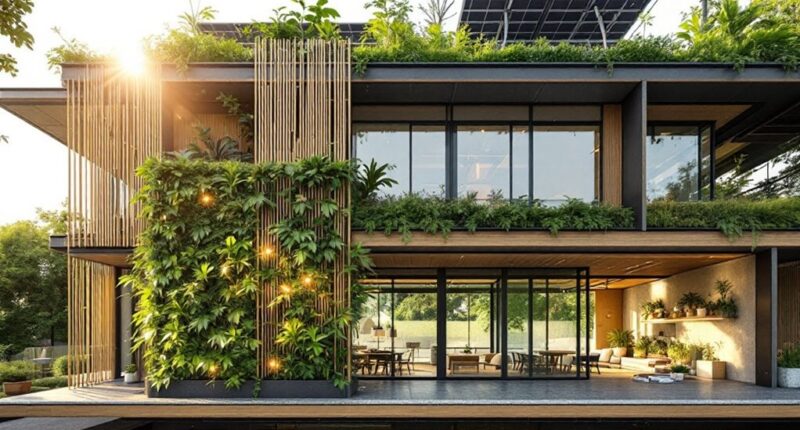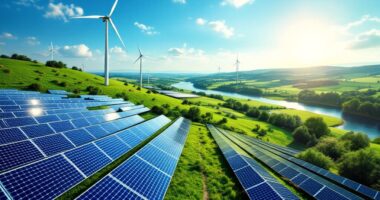Green building merges sustainability with smart design, focusing on eco-friendly materials like bamboo, mass timber, and recycled steel. It incorporates passive solar design, natural ventilation, and daylighting to reduce energy consumption while creating healthier spaces. Certification systems like LEED, BREEAM, and Living Building Challenge provide frameworks for implementation and verification, despite challenges of higher upfront costs and material availability. The approach pays dividends through lower utility bills, increased property values, and a considerably reduced carbon footprint. Beyond construction, it’s a holistic philosophy that transforms how we interact with our built environment.

While traditional construction has long focused on the triumvirate of cost, function, and durability, green building expands this vision into a more holistic approach that considers our planet’s future. This environmentally responsible practice optimizes resources throughout a building’s entire life cycle, from siting to demolition, with the goal of reducing environmental impact while enhancing human health and comfort.
It’s like updating an old recipe – same basic ingredients but with healthier substitutions and more thoughtful preparation.
The materials in a green builder’s toolkit are impressively diverse. Bamboo – nature’s own speed-growing wonder – can replace hardwoods while regenerating in a fraction of the time. Mass timber offers concrete-like strength without the carbon footprint, while recycled steel gives industrial byproducts a second life. Hempcrete and cork provide excellent insulation while sequestering carbon – they’re fundamentally putting greenhouse gases on time-out while keeping your home cozy. Even ceramics and glass can be produced using energy-efficient techniques that reduce environmental impact while maintaining quality and durability.
Smart design strategies are the backbone of sustainable structures. Passive solar design harnesses the sun’s energy without complicated gadgetry – fundamentally letting the building do the work instead of mechanical systems. Natural ventilation creates comfortable indoor environments without energy-hungry HVAC systems, while daylighting techniques flood interiors with natural light, reducing electricity needs. Early implementation of these principles can be traced back to ancient practices of indigenous peoples like the Anasazi, who masterfully incorporated local materials and passive solar design in their villages.
Green roofs and walls act like the building’s own sweater, providing insulation while managing stormwater.
The payoffs are considerable: lower utility bills, healthier indoor environments, higher property values, and a notably reduced carbon footprint. It’s like getting paid to eat your vegetables – good for you and rewarding too.
For those seeking official recognition of their green building prowess, certification systems provide the gold stars. LEED and BREEAM are the popular kids on the block, with Green Globes, Living Building Challenge, and WELL Building Standard offering specialized alternatives. AshCrete offers a sustainable alternative to traditional concrete with its composition of 97% recycled materials and superior strength due to its smaller pores.
These systems provide frameworks for implementation while verifying performance, though challenges remain: higher upfront costs, knowledge gaps, outdated regulations, and limited material availability can make the green building journey less straightforward than we might hope.
Frequently Asked Questions
How Much More Do Green Buildings Cost Than Conventional Ones?
Green buildings typically cost 2-6.5% more upfront than conventional buildings, with LEED-certified structures adding 0-2% to initial costs.
The premium varies by project type: green homes can cost up to 15% more, while commercial buildings average 3-5% higher.
Design costs run 32% higher, and specialized fittings add 32-38% more.
However, these initial investments are offset by long-term operational savings, including 25-30% lower energy costs and reduced maintenance expenses.
Can Existing Buildings Be Retrofitted to Meet Green Standards?
Existing buildings can absolutely be retrofitted to meet green standards.
Deep energy retrofits can reduce energy usage by 40% or more through extensive upgrades.
Professionals can transform older structures by installing efficient HVAC systems, improving insulation, upgrading to LED lighting, and implementing smart controls.
While retrofits present challenges like balancing historic preservation with sustainability goals, they offer significant benefits including reduced operational costs, improved occupant health, and decreased carbon emissions.
What Are the ROI Timeframes for Green Building Investments?
Green building investments typically deliver returns over varying timeframes. Most projects achieve payback within 3-5 years, with about half recovering costs from energy and water savings alone during this period.
Faster returns include 2.5 years for large LEED buildings, while extensive renovations might extend to 10 years.
The financial case strengthens over time with 8-10% higher property values, increased rents, and reduced operational costs—not to mention the bonus of healthier, more productive occupants.
Which Certification Is Most Recognized Internationally?
LEED is the most internationally recognized green building certification, operating in over 165 countries with 195,000+ certified buildings worldwide.
While BREEAM (UK-based) dominates European markets and enjoys strong global recognition, LEED‘s widespread adoption by multinational corporations and governments gives it the edge.
Other significant international certifications include Green Star (Australia), DGNB (Germany), and CASBEE (Japan), each with strong regional influence but less global penetration than LEED.
How Do Green Buildings Impact Occupant Health and Productivity?
Green buildings notably boost occupant health and productivity through multiple pathways.
Their superior indoor air quality reduces respiratory issues and sick building syndrome symptoms. Studies show occupants experience up to 61% higher cognitive function scores and substantially reduced absenteeism – in one case dropping from 96 to 45 hours per person annually.
Elements like natural lighting, outdoor views, and indoor plants further enhance psychological well-being, ultimately translating to measurable productivity gains for businesses.









